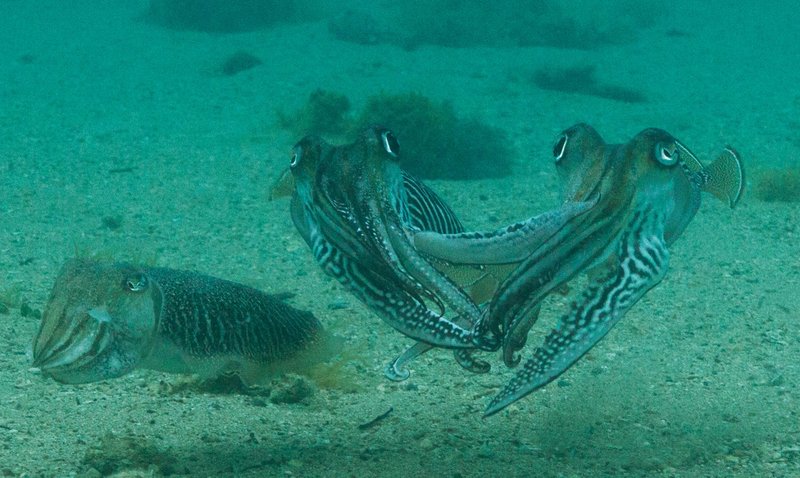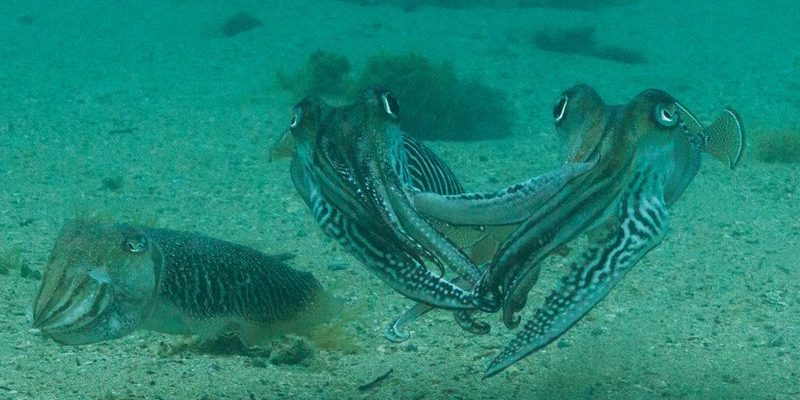
Cuttlefish are fascinating marine animals known for their unique appearance and incredible abilities. They belong to the class Cephalopoda, which also includes octopuses and squids. Imagine a creature that can change color and texture in the blink of an eye—cuttlefish have mastered this skill! With their broad, flattened bodies and large eyes, they look like a blend of squid and flatfish. These creatures are not just beautiful; they are also highly intelligent and skilled hunters.
When you first spot a cuttlefish, you might be struck by their vibrant colors and the way they move gracefully through the water. They are often found in shallow waters, nestled among rocks or hiding in sand, ready to ambush their prey. Their ability to blend into their surroundings is nothing short of remarkable, making it hard for both predators and prey to detect them!
As we explore the world of cuttlefish, you’ll discover their habitats, behaviors, and the secrets of their captivating lives. So, grab a cup of coffee, and let’s dive deeper into what makes these creatures so special!
Physical Characteristics
Cuttlefish possess a range of incredible physical traits that set them apart from other marine creatures. First and foremost, they have a unique internal shell called the cuttlebone. This structure is often found washed up on beaches and is responsible for buoyancy control, enabling these animals to float effortlessly in the ocean. If you’ve ever seen a cuttlebone, you’ll notice it has a distinct, flattened shape that resembles the tail of a bird.
Another defining feature of cuttlefish is their large, expressive eyes. These eyes have excellent vision, allowing them to detect movement and color in their environment. In fact, cuttlefish can see polarized light, giving them an edge when hunting or evading predators. Not to mention, their eyes can move independently, so they’re always alert to whatever is happening around them!
Perhaps the most remarkable aspect of cuttlefish is their ability to change color and texture. They have specialized skin cells called chromatophores, which contain pigment. By contracting or relaxing these cells, cuttlefish can create stunning displays of color that can dazzle or confuse their surroundings. It’s like having a personality that changes with every mood, and these transformations can be vital for communication or camouflage.
Habitat and Distribution
Cuttlefish are found in oceans around the world, from the warm tropical waters to cooler temperate zones. They thrive in coastal areas, where they can find plenty of food and suitable environments for breeding. You might spot them in rocky reefs or sandy bottoms, often hiding among the vegetation to conceal themselves from predators.
Some species, like the common cuttlefish (Sepia officinalis), can be found in the Mediterranean Sea and along the coasts of Europe. Others prefer the warm waters of the Indo-Pacific region. Their adaptability to different environments is one of the reasons they can be so successful across various habitats.
Interestingly, the range of cuttlefish can also be influenced by environmental factors. For instance, changes in water temperature or salinity can affect their movement and distribution. As we consider the health of our oceans, understanding where cuttlefish live and how they adapt helps us appreciate their role in marine ecosystems.
Diet and Hunting Techniques
The diet of a cuttlefish mainly consists of small fish, crustaceans, and other mollusks. As skilled hunters, they utilize their incredible camouflage to ambush prey. Imagine sliding quietly through the water, blending in with your surroundings, and then—bam!—striking with lightning speed. That’s the essence of cuttlefish hunting.
They often employ a technique called “sit-and-wait.” This means they’ll stay still and hidden until the perfect moment arises. When a fish or crab comes close enough, they strike using their powerful tentacles to grab their meal. The cuttlefish’s tentacles are equipped with suckers, allowing them to immobilize their prey quickly.
Another fascinating aspect of their hunting strategy is their ability to use their beaks to crush shells. Cuttlefish have a hard beak similar to that of a parrot, which helps them access the delicate insides of their shelled prey. With their excellent vision and swift movements, cuttlefish are truly masters of the hunt.
Reproduction and Life Cycle
The reproductive behavior of cuttlefish is as captivating as their hunting abilities. During mating season, males will display vibrant colors to attract females. This colorful dance is not just for show; it’s a critical part of their courtship rituals. Once a female chooses a mate, she will lay her eggs in protected areas, such as crevices or on submerged structures.
After the eggs are laid, the female will often guard them until they hatch, showcasing maternal instincts not commonly seen in the animal kingdom. Cuttlefish hatchlings emerge fully formed and miniature versions of their parents, ready to start their lives in the ocean. This strategy gives them a better chance of survival since they can immediately begin hunting on their own.
Cuttlefish have relatively short lifespans, typically ranging from 1 to 2 years. Their rapid growth and development are part of what makes them so fascinating. They reach maturity quickly, which is essential given their short lives. This life cycle reflects the dynamic nature of life in the ocean, where every moment counts!
Conservation Status
While cuttlefish are fascinating creatures, they face various challenges in their natural habitats. Overfishing, habitat destruction, and climate change threaten their populations. Many species are commercially harvested for their meat, which is considered a delicacy in some cultures. As demand grows, it puts pressure on their numbers.
Habitat loss due to pollution and coastal development also poses risks. Healthy ecosystems are essential for cuttlefish, as they rely on diverse marine environments for food and mating grounds. Protecting their habitats is crucial not only for their survival but for the overall health of the ocean.
Efforts to conserve cuttlefish populations include implementing sustainable fishing practices and protecting marine areas. Educating the public about these incredible creatures can also foster appreciation for their role in marine ecosystems. The more we understand and care for cuttlefish, the better chance they have of thriving in our oceans.
Interesting Facts About Cuttlefish
| Size: | Up to 24 inches (60 cm), depending on species. |
| Habitat: | Shallow coastal waters, rocky reefs, sandy bottoms. |
| Diet: | Small fish, crustaceans, other mollusks. |
| Speed: | Can swim quickly using jet propulsion. |
| Lifespan: | 1 to 2 years on average. |
| Color Change: | Can change color and texture in seconds. |
FAQ
How do cuttlefish communicate with each other?
Cuttlefish communicate primarily through color changes and body language. By altering their skin color and texture, they send signals to each other about their intentions, whether it’s attracting a mate or indicating aggression. This visual communication is vital in their social interactions, as it helps them navigate complex relationships in their underwater world.
Can cuttlefish see color?
Yes, cuttlefish can see a range of colors, but their vision is particularly adapted to detect polarized light. This unique ability allows them to see contrast better in their surroundings, giving them an advantage when hunting or evading predators. Their exceptional eyes are one of the reasons they are such effective hunters in the ocean.
Are cuttlefish dangerous to humans?
Cuttlefish are generally not dangerous to humans. They are shy creatures that prefer to avoid confrontation. While they can bite if threatened, their primary defense mechanism is their ability to blend into their surroundings. They rely on camouflage rather than aggression to protect themselves.
How long do cuttlefish live?
Cuttlefish typically live for about 1 to 2 years. Their shorter lifespan is balanced by their rapid growth and maturation. This life cycle means that they can reproduce quickly, which is crucial for their survival in changing environmental conditions.
What do cuttlefish eat?
Cuttlefish are carnivorous and primarily eat small fish, crustaceans, and other mollusks. They are skilled hunters, using their camouflage and speed to ambush unsuspecting prey. Their diet is essential for their growth and reproductive success.
Where can cuttlefish be found?
Cuttlefish inhabit a range of marine environments worldwide, from shallow coastal waters to rocky reefs. They’re commonly found in the Mediterranean Sea and the Indo-Pacific region. Their preference for diverse habitats makes them adaptable to various underwater settings.
Why do cuttlefish change color?
Cuttlefish change color for several reasons, including communication, camouflage, and temperature regulation. By altering their skin color and texture, they can blend in with their surroundings to hide from predators or display vibrant colors to attract mates. This ability is a key factor in their survival and social interactions.
Are cuttlefish intelligent?
Yes, cuttlefish are considered one of the most intelligent invertebrates. They exhibit complex behaviors, including problem-solving and adaptable hunting strategies. Their learning capabilities and impressive camouflage skills indicate a level of intelligence that is quite remarkable in the animal kingdom.
How do cuttlefish reproduce?
Cuttlefish reproduce by laying eggs in protected areas after a courtship display. Males attract females with colorful displays, and once a female selects a mate, she lays her eggs in safe spots. These eggs hatch into miniature adult cuttlefish, ready to navigate life in the ocean.
What threats do cuttlefish face?
Cuttlefish face several threats, including overfishing, habitat loss, and climate change. Overfishing for their meat and pollution in their habitats can lead to declining populations. Protecting their environments and promoting sustainable fishing practices are essential for their conservation.
Can cuttlefish learn new things?
Cuttlefish have demonstrated the ability to learn and adapt to new situations, showcasing their intelligence. They can remember past experiences, which helps them adjust their hunting strategies and interactions with other marine animals effectively.

